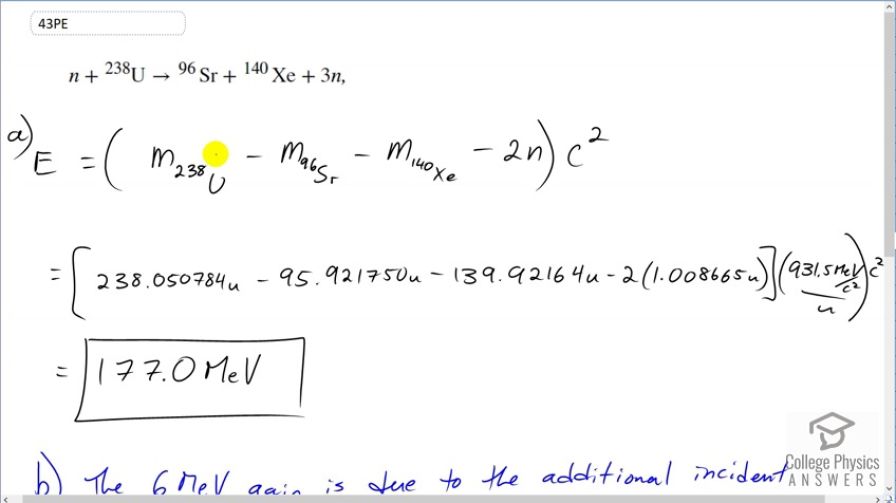Question
(a) Calculate the energy released in the neutron-induced fission (similar to the spontaneous fission in Example 32.3 where
given that and . (b) This result is about 6 MeV greater than the result for spontaneous fission. Why? (c) Confirm that the total number of nucleons and total charge are conserved in this reaction.
given that and . (b) This result is about 6 MeV greater than the result for spontaneous fission. Why? (c) Confirm that the total number of nucleons and total charge are conserved in this reaction.
Final Answer
- The 6 MeV gain is due to the additional incident neutron.
- Please see the solution video.
Solution video
OpenStax College Physics for AP® Courses, Chapter 32, Problem 43 (Problems & Exercises)

vote with a rating of
votes with an average rating of
.
Video Transcript
This is College Physics Answers with Shaun Dychko. We are going to find the energy released in this neutron induced fission and we'll find the total mass that we start with which is uranium-238 and we are not including the mass of the neutron here because on the product side, we have three neutrons but we are going to take away only two. So we could have done, you know, one mass of a neutron here and then minus three mass of neutrons but instead we are just accounting for that ahead of time and writing it as just minus 2. So we have a difference in the atomic mass of uranium-238 and the atomic masses of strontium and xenon combined together and they take away two neutron masses. So these are the numbers we look up in appendix A and these numbers include masses of electron but we don't need to worry about that because the number of protons or electrons surrounding uranium-238 is the same as the number of electrons surrounding the total of strontium and xenon. So the electron masses that are included in this number for uranium are taken away by the electron masses that are included in this mass and this mass. So we have 177.0 megaelectron volts total energy released and this energy is more than spontaneous fission because spontaneous fission doesn't have this neutron there and well it maybe would have a 2 there instead of a 3 and this spontaneous fission since it doesn't have this extra neutron, we should expect it to have less energy. And then in part (c), we have to check the conservation laws and we see that the number of nucleons in uranium is 238 and we have one neutron here for a total of 239 on the left side and then on the right side, 6 and 3 makes 9 and then 9 and 14 makes 23 so we have 239 on the right side as well. And then for charge, we have 92 on the left and then we have atomic number is 38 for strontium and 54 for xenon which totals 92 as well and so that also is a conservation law that checks out.